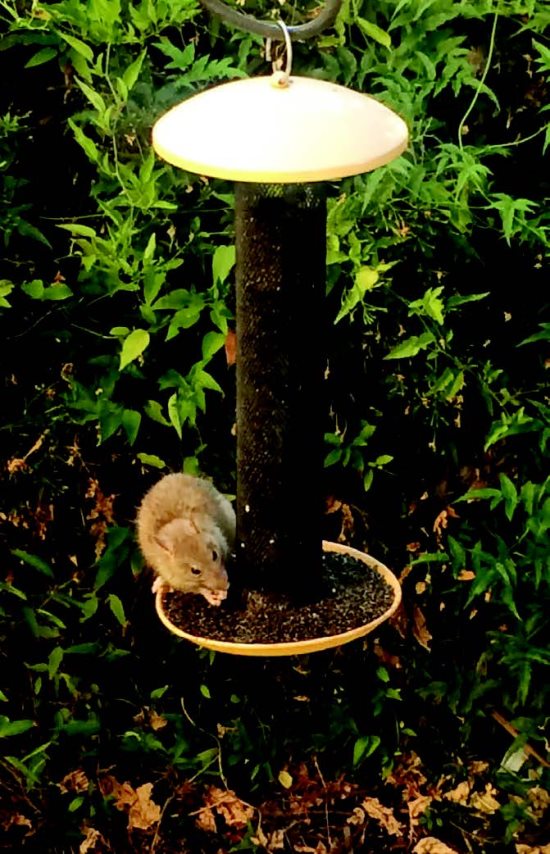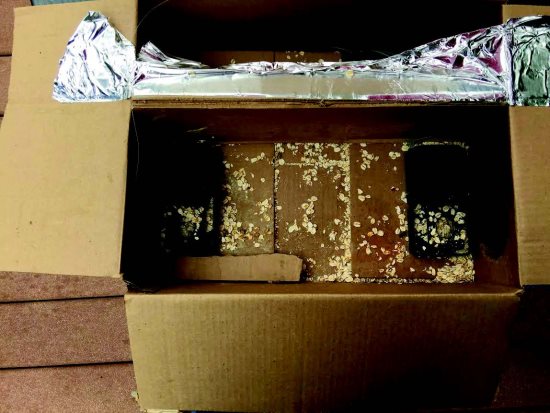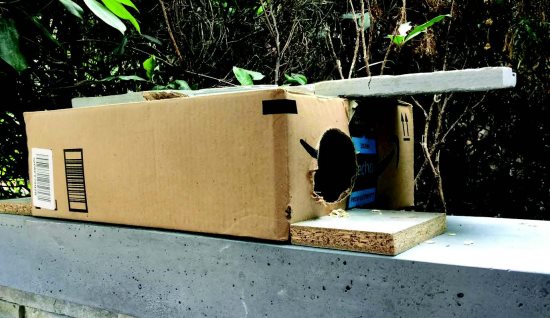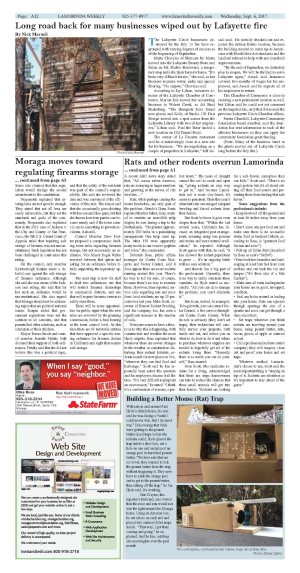| | Published September 6th, 2015
| Oh rats! Rodents and other critters overrun Lamorinda
| | | By Diane Claytor |  | | This bold rat scampered up a pole to munch on seed from a hanging birdfeeder. Photo Jennifer Wake |
The pitter-patter of little feet typically means something smile-worthy - a toddler running down the hall for a hug or a playful puppy scampering about. But these days, that pitter-patter may mean something far less pleasant; it could mean rats are living in your attic or walls, or voles, moles or mice are running across your deck.
 The general consensus is that the rodent population has increased significantly this year in Lamorinda. A NextDoor.com post asking the simple question "Varmints in your yard?" elicited almost 80 responses, most answering yes. They've been found in pools - alive and dead. They've been destroying gardens - feeding on fruits, vegetables and flowers. They're dashing across walking trails and racing through open fields. Paul Hyde of Orinda has even seen rats shimmying down wires in an attempt to reach his bird feeder.
The general consensus is that the rodent population has increased significantly this year in Lamorinda. A NextDoor.com post asking the simple question "Varmints in your yard?" elicited almost 80 responses, most answering yes. They've been found in pools - alive and dead. They've been destroying gardens - feeding on fruits, vegetables and flowers. They're dashing across walking trails and racing through open fields. Paul Hyde of Orinda has even seen rats shimmying down wires in an attempt to reach his bird feeder.
 But it's not just in our area. Reports indicate that the numbers of these very unpopular animals are on the rise throughout the state - and, in fact, throughout the country. A recent ABC news story stated that, "All across urban America, rats are scurrying in larger numbers and gnawing at the nerves of city dwellers ..."
But it's not just in our area. Reports indicate that the numbers of these very unpopular animals are on the rise throughout the state - and, in fact, throughout the country. A recent ABC news story stated that, "All across urban America, rats are scurrying in larger numbers and gnawing at the nerves of city dwellers ..."
 Rats, while perhaps causing the worst headaches, are only part of the problem. Orinda's Dana Fouts reported that her father, Gary, wanted to emulate an incredible tulip display he saw during a trip to the Netherlands. "He planted approximately 200 bulbs in a painstaking arrangement. One tulip came up. The other 199 were apparently many meals to our evasive gophers and voles," she commented.
Rats, while perhaps causing the worst headaches, are only part of the problem. Orinda's Dana Fouts reported that her father, Gary, wanted to emulate an incredible tulip display he saw during a trip to the Netherlands. "He planted approximately 200 bulbs in a painstaking arrangement. One tulip came up. The other 199 were apparently many meals to our evasive gophers and voles," she commented.
 Deborah Bass, public affairs manager for Contra Costa Mosquito and Vector Control, said it does appear there are more rodents running around this year. There's no way to tell for sure, of course, because there's no way to monitor them. However, Bass reported, service calls regarding rats and mice from local residents are up 20 percent over last year. Mike Scott, co-owner of Honest Rodent Proofing, said his company, too, has seen a significant increase in the number of calls.
Deborah Bass, public affairs manager for Contra Costa Mosquito and Vector Control, said it does appear there are more rodents running around this year. There's no way to tell for sure, of course, because there's no way to monitor them. However, Bass reported, service calls regarding rats and mice from local residents are up 20 percent over last year. Mike Scott, co-owner of Honest Rodent Proofing, said his company, too, has seen a significant increase in the number of calls.
 Everyone seems to have a theory as to why this is happening, with construction and weather the most likely culprits. Bass explained that whenever there are severe changes in the weather or construction disturbing their natural habitats, rodents search for new places to live, "wherever they can find food and harborage." Scott said he has repeatedly been asked this question and his employees discuss it all the time. "It's very difficult to pinpoint an exact reason," he stated. "I think it's a combination of reasons, a perfect storm." The years of drought caused the soil to crack and open up, "giving rodents an easy way to get in." And because Lamorinda soil is more clay-based, it's easier to penetrate. Then this year's abundant rain encouraged rampant breeding and forced rodents from their homes.
Everyone seems to have a theory as to why this is happening, with construction and weather the most likely culprits. Bass explained that whenever there are severe changes in the weather or construction disturbing their natural habitats, rodents search for new places to live, "wherever they can find food and harborage." Scott said he has repeatedly been asked this question and his employees discuss it all the time. "It's very difficult to pinpoint an exact reason," he stated. "I think it's a combination of reasons, a perfect storm." The years of drought caused the soil to crack and open up, "giving rodents an easy way to get in." And because Lamorinda soil is more clay-based, it's easier to penetrate. Then this year's abundant rain encouraged rampant breeding and forced rodents from their homes.
 But Scott believes it goes even deeper than that. "Within the last several years, California has focused on integrated pest management, meaning using less poisons and toxins and more natural eradication," he reported. Although Scott agrees with that, he said, "it has allowed the rodent population to grow. ... It's an ongoing battle with no easy solution."
But Scott believes it goes even deeper than that. "Within the last several years, California has focused on integrated pest management, meaning using less poisons and toxins and more natural eradication," he reported. Although Scott agrees with that, he said, "it has allowed the rodent population to grow. ... It's an ongoing battle with no easy solution."
 And therein lies a big part of the predicament. Currently, there is no way to safely eliminate these varmints. As Hyde stated so succinctly, "All you can do is manage the problem; you can't eliminate it."
And therein lies a big part of the predicament. Currently, there is no way to safely eliminate these varmints. As Hyde stated so succinctly, "All you can do is manage the problem; you can't eliminate it."
 But it can, indeed, be managed. To begin with, you can contact Vector Control, a free service throughout Contra Costa County. While its role is advisory (they don't set traps), their technicians will carefully survey your property, both inside and out, and advise you on what to do, how to do it and where to purchase whatever supplies are needed to hopefully get rid of the rodents living there. "Honestly, there is so much you can do yourself," Bass assured.
But it can, indeed, be managed. To begin with, you can contact Vector Control, a free service throughout Contra Costa County. While its role is advisory (they don't set traps), their technicians will carefully survey your property, both inside and out, and advise you on what to do, how to do it and where to purchase whatever supplies are needed to hopefully get rid of the rodents living there. "Honestly, there is so much you can do yourself," Bass assured.
 Even Scott, who eradicates rodents for a living, acknowledged that there are steps homeowners can take to reduce the chances that these small animals will get into their homes. "Rodents are looking for a safe haven, someplace they can hide," Scott said. "There's no magic potion but it's all about cutting off their food source and preventing them from finding that safe haven."
Even Scott, who eradicates rodents for a living, acknowledged that there are steps homeowners can take to reduce the chances that these small animals will get into their homes. "Rodents are looking for a safe haven, someplace they can hide," Scott said. "There's no magic potion but it's all about cutting off their food source and preventing them from finding that safe haven."
 Some suggestions from the professionals include:
Some suggestions from the professionals include:
 � Keep firewood off the ground and at least 18 inches away from your house.
� Keep firewood off the ground and at least 18 inches away from your house.
 � Don't leave any pet food out and make sure there is no accessible water, food or birdseed (which, according to Bass, is "gourmet food for rats and mice").
� Don't leave any pet food out and make sure there is no accessible water, food or birdseed (which, according to Bass, is "gourmet food for rats and mice").
 � Pick up all fallen fruit (described by Bass as a rat's "buffet").
� Pick up all fallen fruit (described by Bass as a rat's "buffet").
 � Trim back tree branches and landscaping at least four feet from your roofline and cut back the ivy and juniper ("it's their idea of a Ritz Carlton").
� Trim back tree branches and landscaping at least four feet from your roofline and cut back the ivy and juniper ("it's their idea of a Ritz Carlton").
 � Make sure all vents leading under your house are in good, un-ripped, condition.
� Make sure all vents leading under your house are in good, un-ripped, condition.
 � Seal any holes around or leading into your house. Rats can squeeze through openings the size of a quarter and mice can get through a dime-sized hole.
� Seal any holes around or leading into your house. Rats can squeeze through openings the size of a quarter and mice can get through a dime-sized hole.
 � Set traps wherever you think rodents are traveling around your house, using peanut butter, nuts, bacon, pieces of apple or oatmeal as bait.
� Set traps wherever you think rodents are traveling around your house, using peanut butter, nuts, bacon, pieces of apple or oatmeal as bait.
 � Call a professional rodent control company; they will inspect, clean out and proof your house and set traps.
� Call a professional rodent control company; they will inspect, clean out and proof your house and set traps.
 Whatever method Lamorindan's choose to use, Scott said the most important thing is "staying on top of it. Rodents are relentless so it's important to stay ahead of the game."
Whatever method Lamorindan's choose to use, Scott said the most important thing is "staying on top of it. Rodents are relentless so it's important to stay ahead of the game."

|
 | | Building a Better Mouse (Rat) Trap With rats in and around Paul Hyde's Orinda home, he realized he was facing a "battle I could never win. But I declared war." Discovering that birds were getting to the peanut butter-laced traps before the rodents could, Hyde placed the trap inside a shoe box, cut a hole on one end and placed an orange peel in hardened peanut butter. "We have rats that are so clever, they learned to lick the peanut butter from the trap without triggering it. They now have to yank the orange peel out to get to the peanut butter, thus setting off the trap." So far, Hyde said, it's working. Dan Claytor, this reporter's husband, also vowed that the mice and rats would not win the fight around his Moraga home. Using an Amazon box, he cut a hole on each end and placed two oatmeal-filled traps inside. "That way, I get them coming and going," he explained. And he has, catching one most nights over the past month. |  | | This contraption, contrived by Dan Claytor, traps rats as they dine. Photos Diane Claytor | | | | | | | | | |






